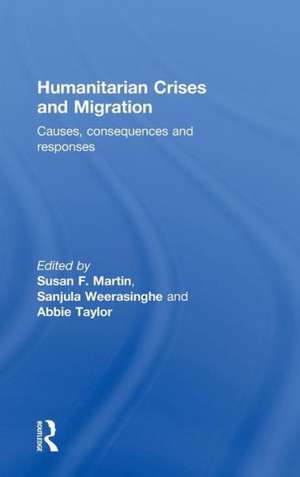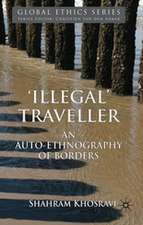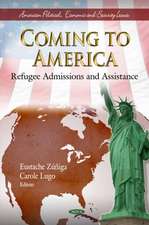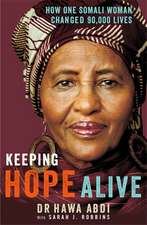Humanitarian Crises and Migration: Causes, Consequences and Responses
Editat de Susan Martin, Sanjula Weerasinghe, Abbie Tayloren Limba Engleză Hardback – 30 apr 2014
This timely book brings together leading experts from multi-disciplinary backgrounds to reflect on diverse humanitarian crises and to shed light on a series of exploratory questions: In what ways do people move in the face of crisis situations? Why do some people move, while others do not? Where do people move? When do people move, and for how long? What are the challenges and opportunities in providing protection to crisis migrants? How might we formulate appropriate responses and sustainable solutions, and upon what factors should these depend? This volume is divided into four parts, with an introductory section outlining the parameters of "crisis migration," conceptualizing the term and evaluating its utility. This section also explores the legal, policy and institutional architecture upon which current responses are based. Part II presents a diverse set of case studies, from the earthquake in Haiti and the widespread violence in Mexico, to the ongoing exodus from Somalia, and environmental degradation in Alaska and the Carteret Islands, among others. Part III focuses on populations that may be at particular risk, including non-citizens, migrants at sea, those displaced to urban areas, and trapped populations. The concluding section maps the global governance of crisis migration and highlights gaps in current provisions for crisis-related movement across multiple levels.
This valuable book brings together previously diffuse research and policy issues under the analytical umbrella of "crisis migration." It lays the foundations for assessing and addressing real challenges to the status quo, and will be of interest to scholars, policy makers, and practitioners committed to seeking out improved responses and ensuring the dignity and safety of millions who move in the context of humanitarian crises.
| Toate formatele și edițiile | Preț | Express |
|---|---|---|
| Paperback (1) | 302.05 lei 6-8 săpt. | |
| Taylor & Francis – 17 apr 2014 | 302.05 lei 6-8 săpt. | |
| Hardback (1) | 819.65 lei 6-8 săpt. | |
| Taylor & Francis – 30 apr 2014 | 819.65 lei 6-8 săpt. |
Preț: 819.65 lei
Preț vechi: 1105.39 lei
-26% Nou
Puncte Express: 1229
Preț estimativ în valută:
156.88€ • 163.51$ • 130.60£
156.88€ • 163.51$ • 130.60£
Carte tipărită la comandă
Livrare economică 06-20 ianuarie 25
Preluare comenzi: 021 569.72.76
Specificații
ISBN-13: 9780415857314
ISBN-10: 0415857317
Pagini: 400
Ilustrații: 14
Dimensiuni: 156 x 234 x 25 mm
Greutate: 0.7 kg
Ediția:New.
Editura: Taylor & Francis
Colecția Routledge
Locul publicării:Oxford, United Kingdom
ISBN-10: 0415857317
Pagini: 400
Ilustrații: 14
Dimensiuni: 156 x 234 x 25 mm
Greutate: 0.7 kg
Ediția:New.
Editura: Taylor & Francis
Colecția Routledge
Locul publicării:Oxford, United Kingdom
Public țintă
Postgraduate, Professional, and UndergraduateCuprins
Part One: Introduction and a Theoretical Perspective Chapter 1: Setting the Scene Chapter 2: Conceptualizing "Crisis Migration": A Theoretical Perspective Part Two: Case Studies of Humanitarian Crises: Movements, Protection Implications and Responses Chapter 3: Rising Waters, Broken Lives: Experience from Pakistan and Colombia Floods Suggests New Approaches are NeededChapter 4: Recurrent Acute Disasters, Crisis Migration: Haiti Has Had It All Chapter 5: Health Crises and Migration Chapter 6: Criminal Violence, Displacement, and Migration in Mexico and Central America Chapter 7: Intractability and Change in Crisis Migration: North Koreans in China and Burmese in Thailand Chapter 8: Environmental Processes, Political Conflict and Migration: A Somali Case Study Chapter 9: Environmental Stress, Displacement and the Challenge of Rights Protection Chapter 10: Enhancing Adaptation Options and Managing Human Mobility in the Context of Climate Change Chapter 11: Community Relocations: The Arctic and South Pacific Chapter 12: Something Old and Something New: Resettlement in the Twenty First Century Part Three: At Risk Populations Chapter 13: Protecting Non-Citizens in Situations of Conflict, Violence, and Disaster Chapter 14: ‘Trapped’ Populations: Controls on Mobility at Times of Crises Chapter 15: Policy Adrift: The Challenge of Mixed Migration By Sea Chapter 16: Flight to the Cities: Urban Options and Adaptations Part Four: Governance Chapter 17: The Global Governance of Crisis Migration
Recenzii
"This innovative volume develops an intriguing new conceptual framework on forced migration at the outset of a multi-year project undertaken by the Institute for the Study of International Migration at Georgetown University." – Journal of International Humanitarian Legal Studies, Benoit Mayer, Wuhan University
"The volume brings together an impressive array of 24 authors, many of them wellknown names, who hold various combinations of expertise in academic research, policy, and practice. Readers will presumably have equally diverse backgrounds and appreciate different parts of the book." – Journal of Refugee Studies, Jørgen, Peace Research Institute Oslo (PRIO)
"This breadth of focus—on those who move both across borders and within countries, along with those who are not able to move—is analytically ambitious but effectively addressed by the first two chapters of the book." – Refuge, James Milner, Carleton University
"The volume brings together an impressive array of 24 authors, many of them wellknown names, who hold various combinations of expertise in academic research, policy, and practice. Readers will presumably have equally diverse backgrounds and appreciate different parts of the book." – Journal of Refugee Studies, Jørgen, Peace Research Institute Oslo (PRIO)
"This breadth of focus—on those who move both across borders and within countries, along with those who are not able to move—is analytically ambitious but effectively addressed by the first two chapters of the book." – Refuge, James Milner, Carleton University
Descriere
This edited volume brings together leading experts from multi-disciplinary backgrounds to address the broad range of movements caused or occurring in the context of acute and slow-onset humanitarian crises.












